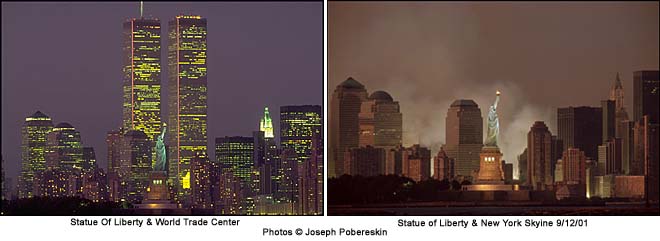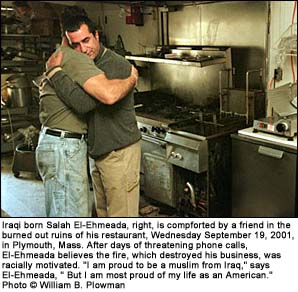|
Joseph
Pobereskin:
Though I've worked for many magazines I'm not a photojournalist,
per se. I'm a commercial photographer with a heavy reliance on
income from stock photography royalties. And a good portion of
those royalties are derived from my photographs of New York City.
Not to diminish the importance of the human story, and with no
disrespect intended, or insensitivity to the victims of Tuesday's
disaster, but I couldn't help thinking about all of those pictures
of the World Trade Center that I've shot over the years. From
the east, from the west, from the north, from the south, from
the ground, from the air, at dawn, at dusk, on clear days, on
hazy days, on good days and on bad days. I've shot those buildings
until I couldn't shoot them any more.
I began to shoot New York again, for the first time in a long
time. I went back to one of my favorite spots at sunset Wednesday,
Sept. 12, to shoot New York City. I don't know how many dozens
of times I've shot NYC from there, and I can't believe how strange
it was to be without my old friends and favorite subjects. There
was only a cloud of smoking dust where the Twin Towers used to
be.

As I walked the last quarter mile or so from my car, I could see
of another photographer unpacking his gear. I couldn't make out
the face from far away but I could tell by the shape of his luggage
that it was an old friend and mentor out there that night, doing
exactly the same as I. He was just setting up as I reached our
favorite spot. I said, "Jake, why am I not surprised to see
you?" He said, "Man, am I glad you're here!"
We stayed together until about ten o'clock, a good two hours after
we were done shooting, trying to comprehend what we were looking
at. It was just too bizarre. We couldn't believe what we were
seeing. It was out of a nightmare. It's difficult to view your
home town in smoking ruin. Even from across the harbor, these
pictures were very difficult to make.
I've been documenting New York City for almost twenty years and
I have an intimate relationship with these buildings and, by either
extension or personal connection, the people who inhabited them
day and night. Photographing the city now, in perhaps its darkest
hour, is an integral part of the story. When the smoke clears,
I'll begin re-shooting this 'new city' in earnest, all the while
remembering what is missing from the scenery - and the people
that are no longer in the picture.
_______
|


 Klaus
Reisinger:
Klaus
Reisinger: